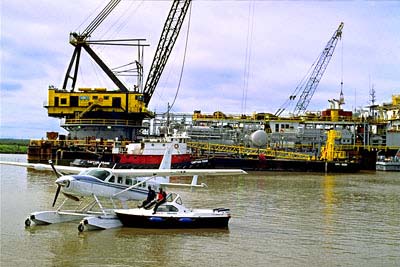Myth of the Single Engine Aircraft
![]()
With Two Engines You Have Twice the Chance of One Quitting...
![]()

The idea that certain companies will not award
contracts to bids or proposals with single engine aircraft is based on a
myth. The concern is that a single engine would quit and kill their
passengers, while twin-engine aircraft have a second engine to pull you
out of the death grip that awaits all heedless company managers. In
reality, however, piston twin engine aircraft had more accidents than did
piston single engine aircraft. Let’s face facts; there is twice as much
chance for one of the two engines to fail than if you only had the one.
That in it self was not the problem, because the logical conclusion to
that argument would be that a 747 is dangerous because you have four times
as much chance of having an engine failure.
The problem was when you had two engines many
companies would push the maintenance and rebuilding envelopes to the
breaking limits, because, the managers would reason, “you had two
instead of only one.”
Then of course, with two engines you could carry
more of a load, not withstanding the POH, because, well….you could. More
power and bigger payload was often the justification for buying a twin
engine aircraft. Of course the weight and balance would go out the window,
but “what the hell” the carriers made more money. “Move over Mr. VP
of BP, we have several bags of cement to carry to the work site. You won’t
mind will you”?
Lets recapitulate. One, statistics are on
the side that with two piston engines you have TWICE the chance of having
one of the engines fail. Two, the maintenance department would extend the
TBO’s and service intervals, with the reasoning that with two
over-extended engines are safer than one well maintained engine. Three,
with more power the operators could overload the twin engine aircraft
until they performed much worse when the statistically doomed engine would
fail, than a properly loaded single engine aircraft would. Thus the piston
engine twins were falling out of the skies quicker than you could say, “buttered
bricks.”
Consequently, someone coined the instructional
phrase, “If you lose one engine, pull the good one otherwise she will
just take you to the scene of the accident quicker.”
Worldly-wise Nabil Haqui of Aero
Contractors says, “Guns don’t kill people, people do!” He continues
to say, “Of course any piston twin would be safer than a single if the
operators flew within the confines of the POH and the manufacturers
limitations."
And, may I add, “did all maintenance with the
consciousness of knowing that your passengers were going to have to rely
on that one engine one day to perform like it was the only engine.” But,
the reality is that the operators happily pulled the trigger.
The “wish they could fly by the numbers”
ex-military aviation managers of BP, Texaco, Shell and others, would award
that contract accordingly “by the book,” dooming themselves to the
myth that precludes the modern cost effective class of aircraft that are
revolutionizing the general aviation world.
The class I am referring to of course
includes such state of the art aircraft as the Cessna Caravan and the
Pilatus PC-12. The fact is, consequentially, that such turbine
single engine aircraft are much safer than the piston twin engine
aircraft, which made a farce out of BP’s guidelines for awarding
contracts based on the number of engines rather than the overall safety of
the aircraft. I realize that these companies would not award contracts to
piston powered aircraft over turbine powered, but the idea of not
considering the single engine turbine aircraft is based on faulty logic.

Article and Images by John S Goulet
![]()
Write to PropThrust with your ideas of what is right from wrong and get published on Virtual Horizons.
Use the attitude indicator as your guide back to eBush Communications.
 Top of this story.
Top of this story.
Last modified on
March 05, 2006 .
© Virtual Horizons, 1996.